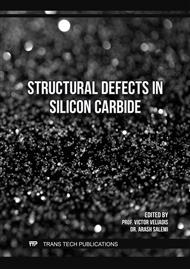[1]
A. Galeckas, J. Linnros, and P. Pirouz, Appl. Phys. Lett., vol.81 (2002), p.883.
Google Scholar
[2]
M. Skowronski and S. Ha, J. Appl. Phys., vol. 99 (2006) 011101.
Google Scholar
[3]
A. Agarwal, H. Fatima, S. Haney, and S.-H. Ryu, IEE Electron Device Lett., vol. 28 (2007), p.587.
Google Scholar
[4]
R. Stahlbush, Q. Zhang, A. Agarwal, and N. A. Mahadik, Mater. Sci. Forum, vol. 717-720 (2012), p.387.
Google Scholar
[5]
S. A. Mancini, S. Y. Jang, Z. Chen, D. Kim, J. Lynch, Y. Liu, B. Raghothamachar, M. Kang, A. Agarwal, N. Mahadik, R. Stahlbush, M. Dudley, and W. Sung, Proc. IRPS 2022, pp.62-1
DOI: 10.1109/irps48227.2022.9764538
Google Scholar
[6]
S. Yamamoto, Y. Nakao, N. Tomita, S. Nakata, and S. Yamakawa, Mater. Sci. Forum, vol. 778-780 (2014), p.951.
Google Scholar
[7]
T. Ishigaki, T. Murata, K. Kinoshita, T. Morikawa, T. Oda, R. Fujita, K. Konishi, Y. Mori, and A. Shima, Proc. ISPSD 2019, p.259.
DOI: 10.1109/ispsd.2019.8757598
Google Scholar
[8]
M. Uchida, N. Horikawa, K. Tanaka, K. Takahashi, T. Kiyosawa, M. Hayashi, M. Niwayama, O. Kusumoto, K. Adachi, C. Kudou, and M. Kitabatake, IEDM Tech. Dig., (2011), 26.6.1.
DOI: 10.1109/iedm.2011.6131620
Google Scholar
[9]
T. Tawara, T. Miyazawa, M. Ryo, M. Miyazato, T. Fujimoto, K. Takenaka, S. Matsunaga, M. Miyajima, A. Otsuki, Y. Yonezawa, T. Kato, H. Okumura, T. Kimoto, and H. Tsuchida, J. Appl. Phys., vol. 120 (2016), pp.115101-1.
DOI: 10.1063/1.4962717
Google Scholar
[10]
S. Hino, H. Hatta, K. Sadamatsu, Y. Nagahisa, S. Yamamoto, T. Iwamatsu, Y. Yamamoto, M. Imaizumi, S. Nakata, and S. Yamakawa, Mater. Sci. Forum, vol. 897 (2017), p.477.
DOI: 10.4028/www.scientific.net/msf.897.477
Google Scholar
[11]
Y. Ebihara, J. Uehara, A. Ichimura, S. Mitani, M. Noborio, Y. Takeuchi, and K. Tsuruta, Proc. ISPSD 2019, p.35.
Google Scholar
[12]
K. Ishibashi, H. Amishiro, T. Tanaka, N. Tomita, A. Imai, Y. Nakao, H. Watanabe, Y. Kagawa, and A. Furukawa, Proc. PCIM Europe 2023, p.167.
Google Scholar
[13]
M. Kato, O. Watanabe, T. Mii, H. Sakane, and S. Harada, Sci. Rep., vol. 12 (2022) 18790.
Google Scholar
[14]
R. Stahlbush, N. Mahadik, P. Bonanno, J. Soto, B. Odekirk, W. Sung, and A. Agarwal, Proc. IRPS 2022, pp.65-1
DOI: 10.1109/irps48227.2022.9764473
Google Scholar
[15]
K. Konishi, S. Yamamoto, S. Nakata, Y. Nakanishi, T. Tanaka, Y. Mitani, N. Tomita, Y. Toyoda, and S. Yamakawa, J. Appl. Phys., vol. 114 (2013), p.014504.
Google Scholar


